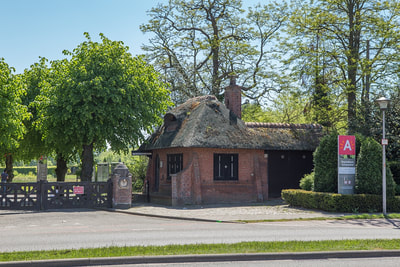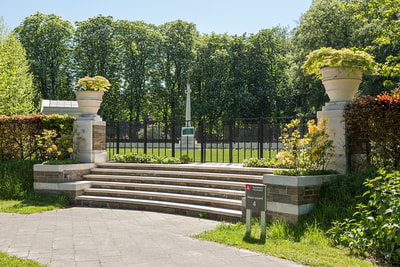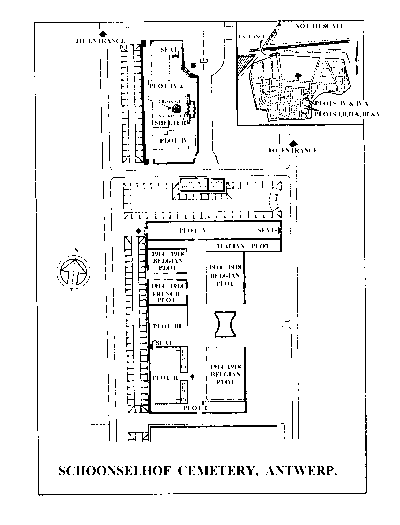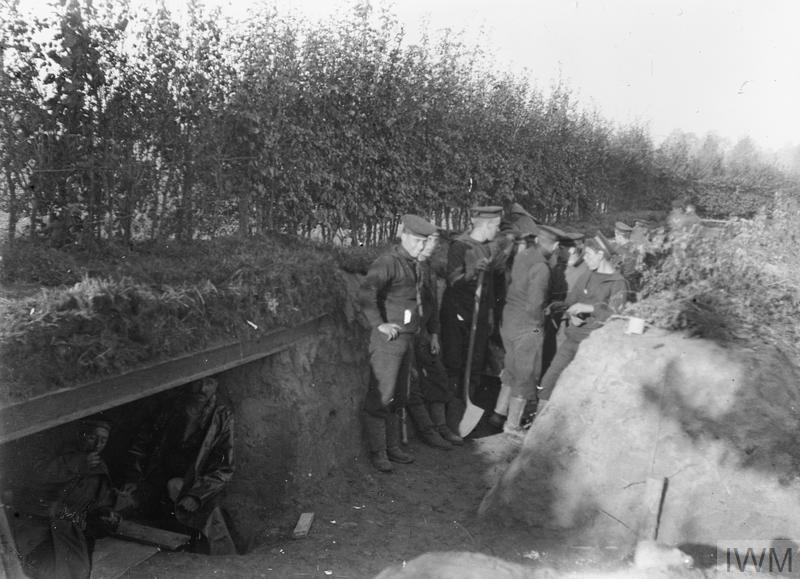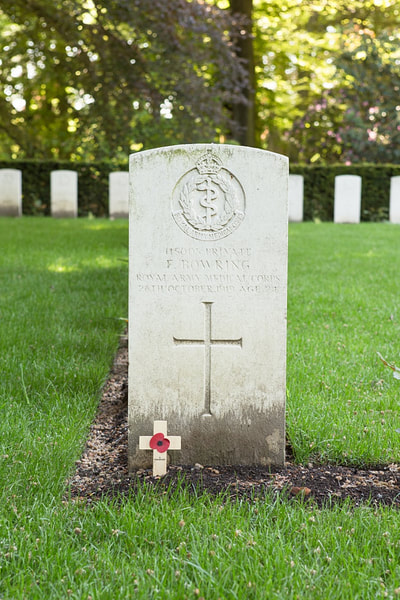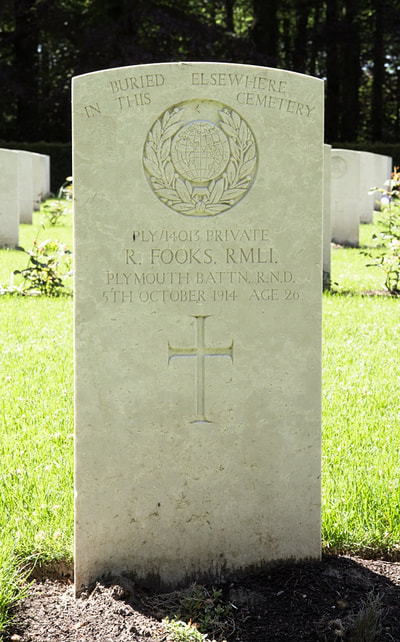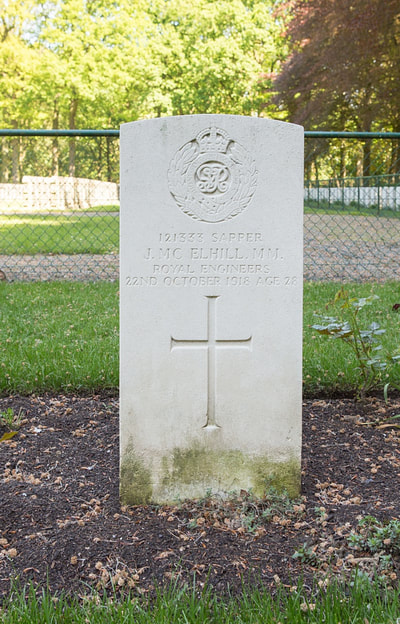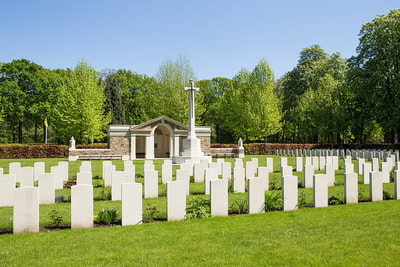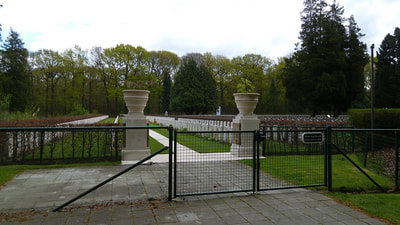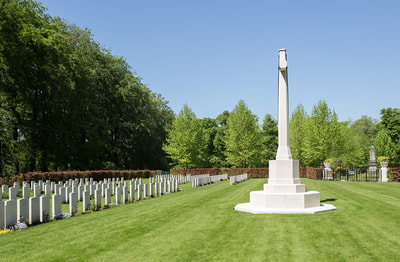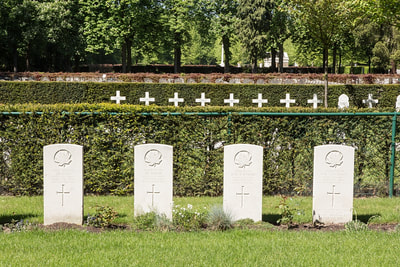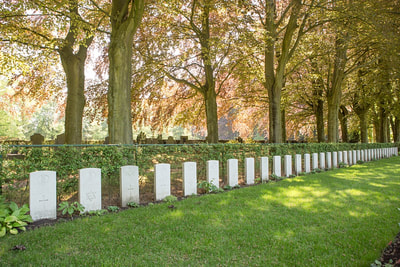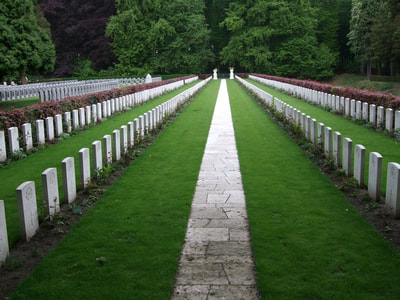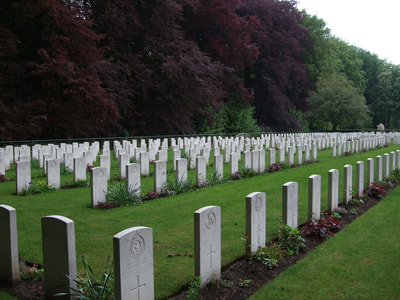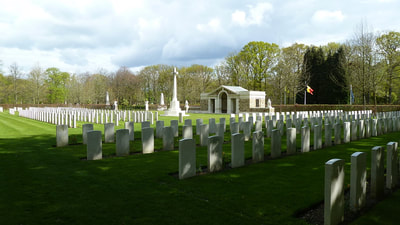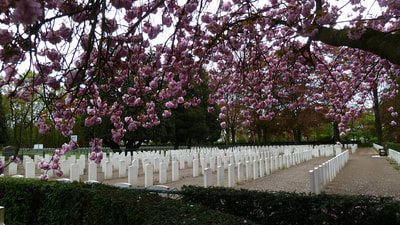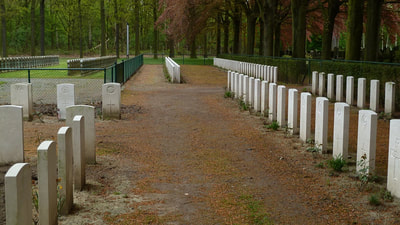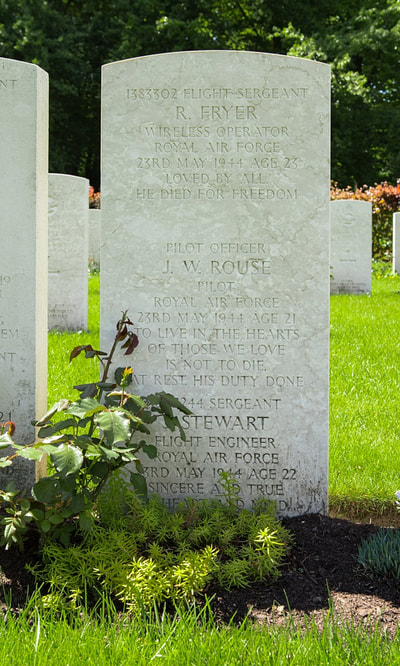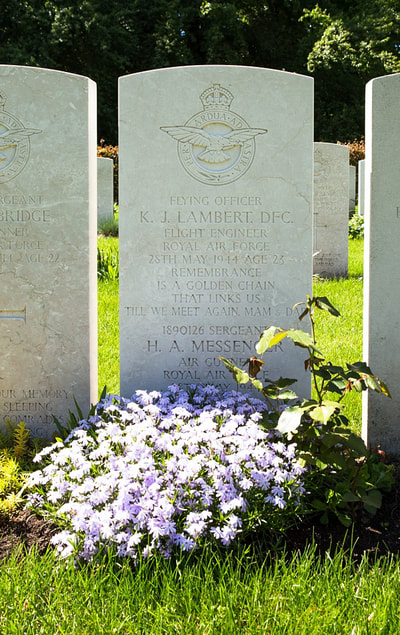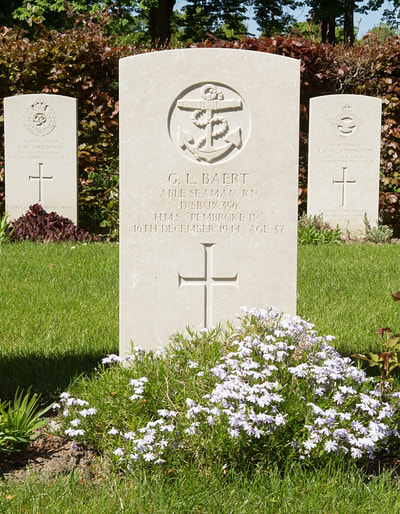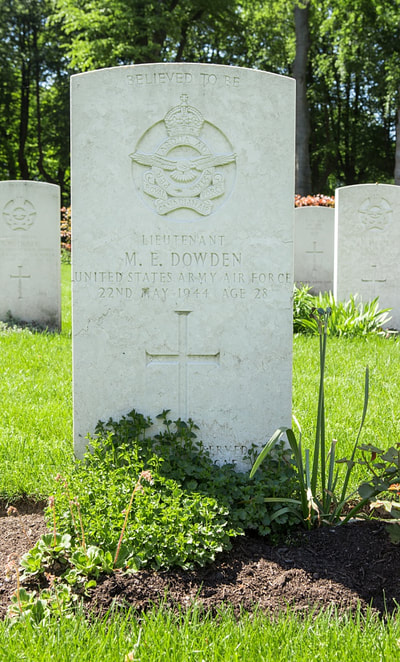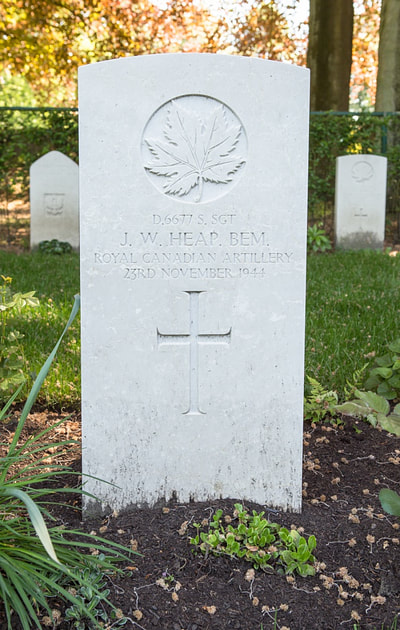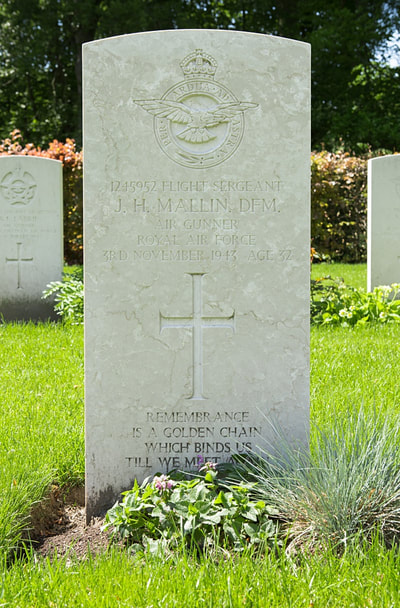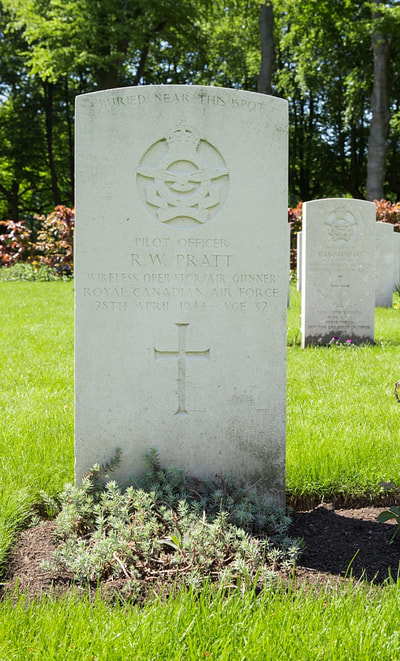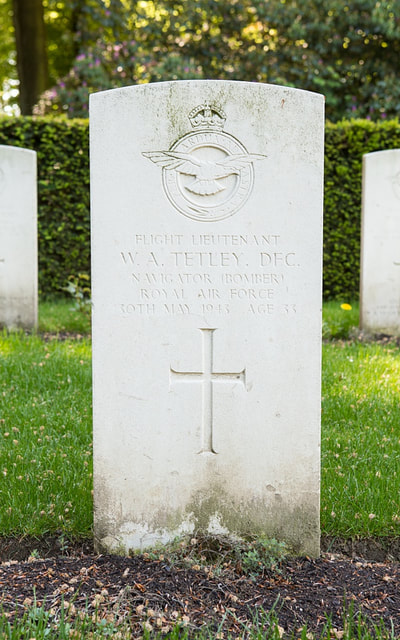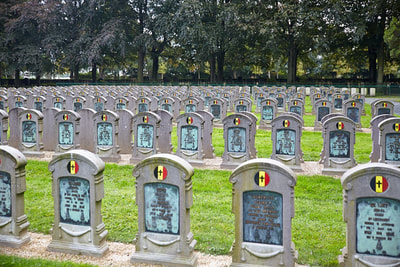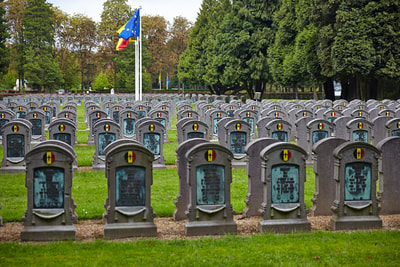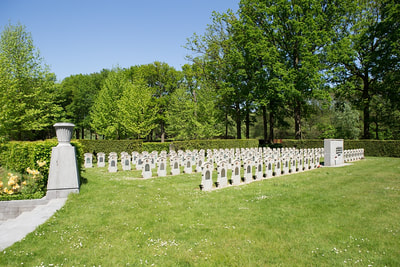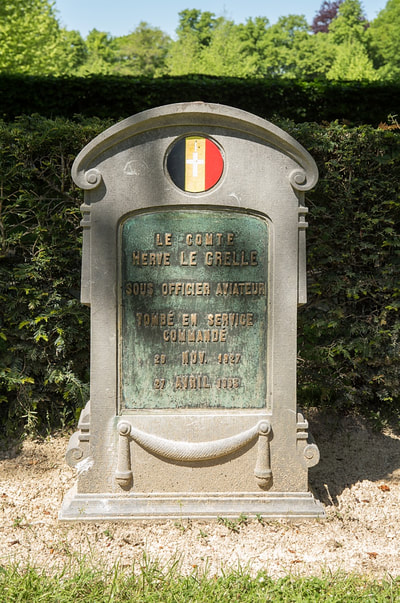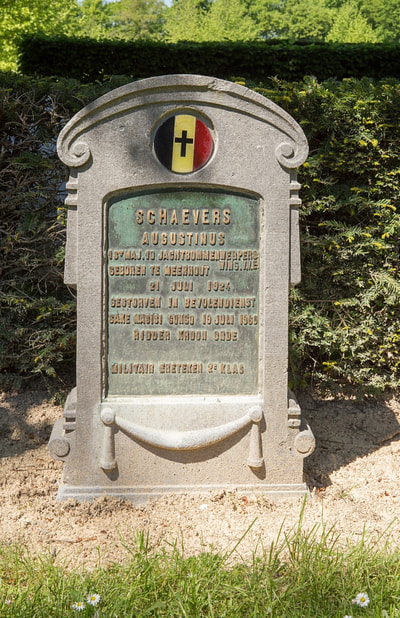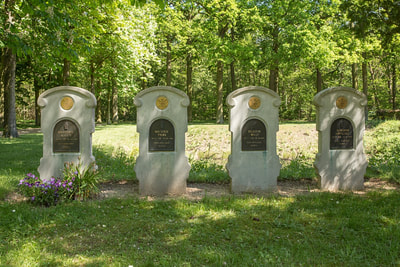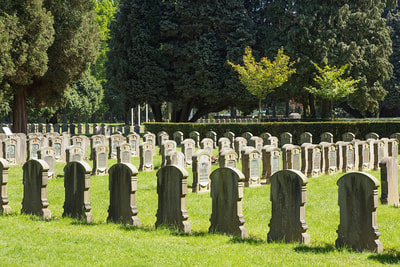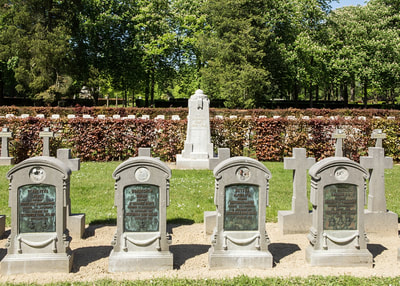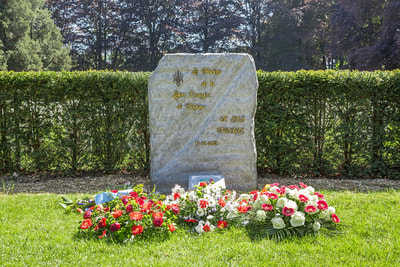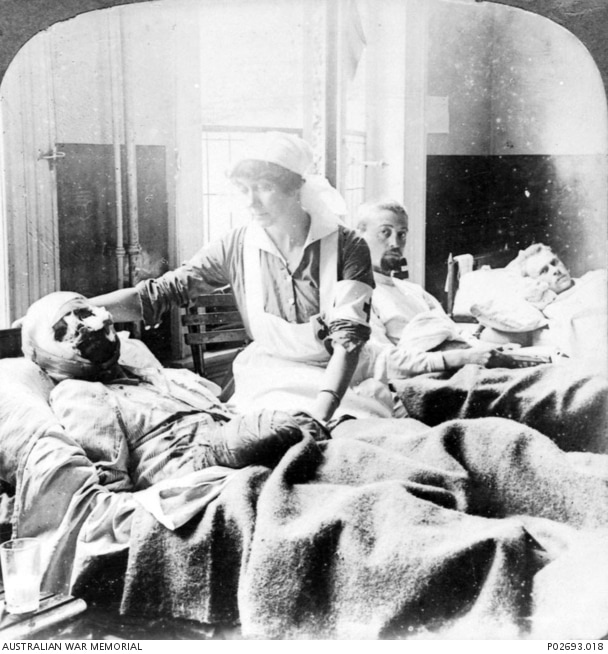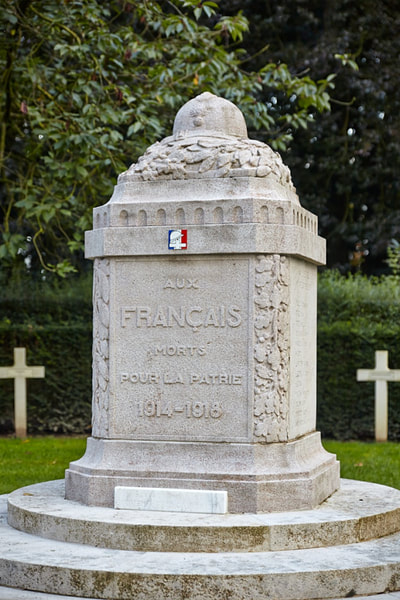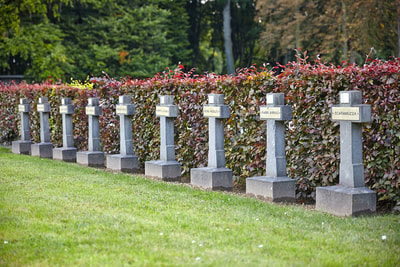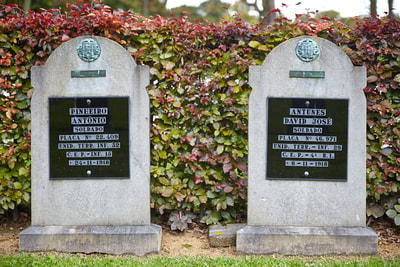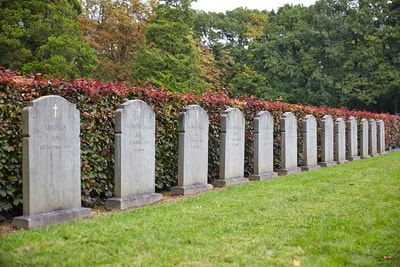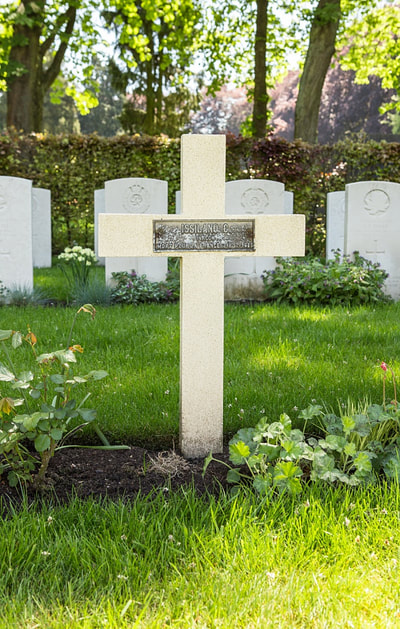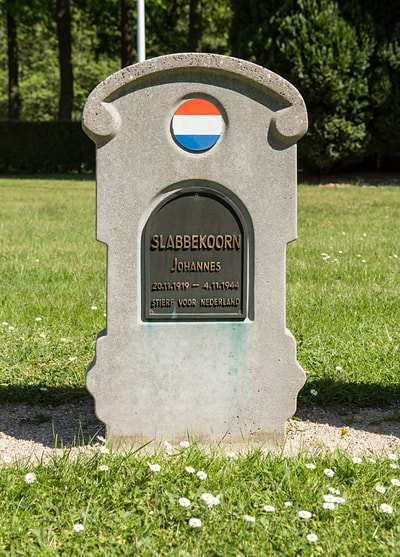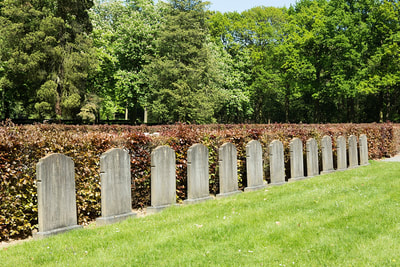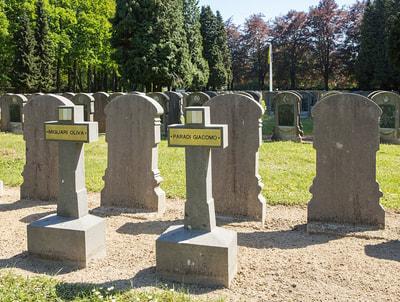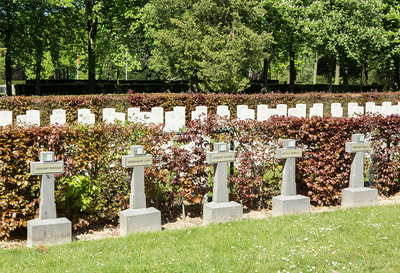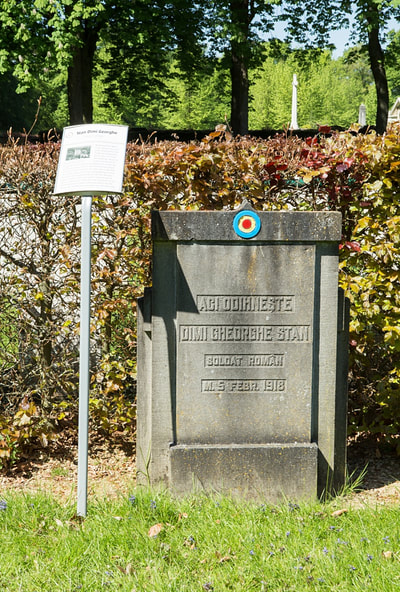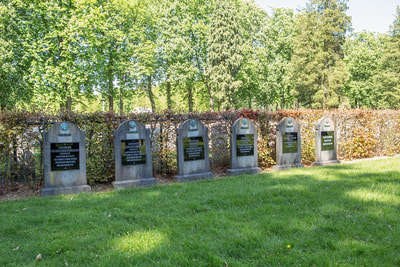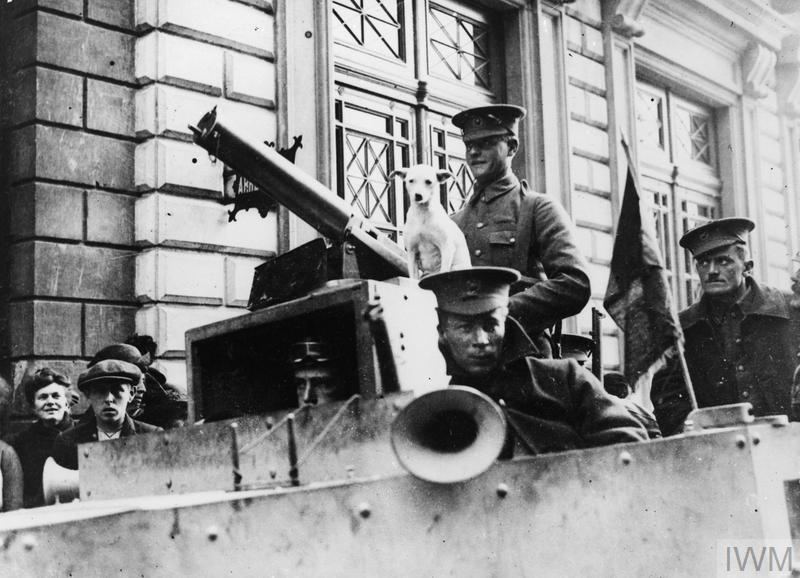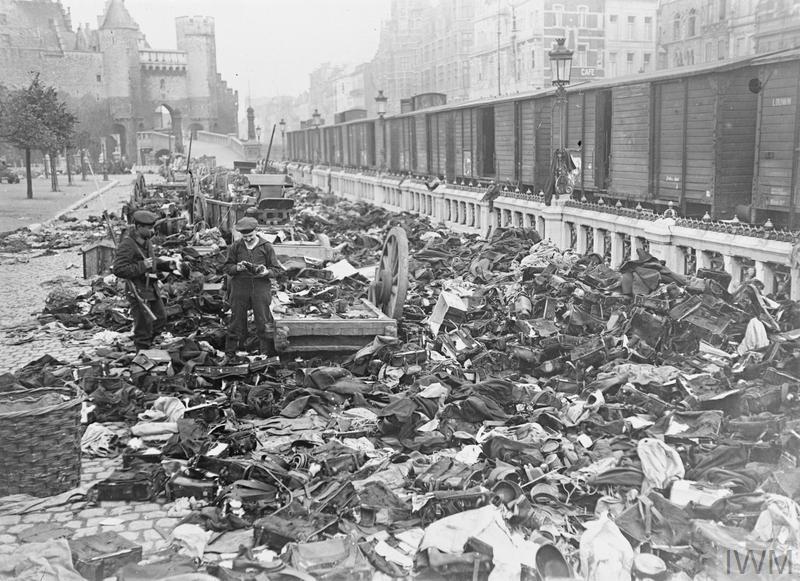SCHOONSELHOF CEMETERY
Antwerpen
Belgium
GPS Coordinates - Latitude: 51.16855, Longitude: 4.36366
Location Information
Antwerp lies 57 Km north of Brussels on the E19 and 59 km north east of Gent on the E17 motorway.
The cemetery itself is located in Wilrijk, a suburb of Antwerp. From the centre follow the Kleine Steenweg until you arrive at the ring road. Turn right and follow the ring road for 250 M to the first set of traffic lights and turn left. Go under the flyover and continue straight on over the dual carriageway into Jules Moretus Lei. Follow this street for 800 M and the entrance to the Municipal Cemetery is on your left. After entering the cemetery follow the Commission signs to the three Commission plots at the far end of the cemetery.
Alternatively ask for their location at the office within the cemetery.
Visiting Information
The opening hours for the cemetery are as follows :- Every day 0830-1630.
Wheelchair access is possible via main entrance.
Historical Information
Antwerp was the seat of the Belgian Government from 17 August to 7 October 1914. Towards the end of August, the city was one of the strong positions on the Allied left flank, and by the middle of September, a position of critical importance. It was defended by fortress troops and the greater part of the Belgian Field Army and the Royal Naval Air Service used its aerodrome. On 27 September the Germans laid siege to Antwerp and during the first week of October the Royal Naval Division entered the city, playing a crucial part in its defence. On 9 October, before other British and French reinforcements could arrive, the last forts became untenable and the last defenders retired. From 10 October 1914 to the Armistice, the city was in German hands.
German forces returned to Belgium in May 1940, and occupied Antwerp until its liberation by the Allies on 4 September 1944. The town and port were secured, but it was some weeks further before the approaches from the North Sea could be cleared of German resistance.
Schoonselhof Cemetery contains 101 Commonwealth burials of the First World War, some of which were brought in from other burial grounds in the area after the Armistice (17 of them were brought in from Lierre German Cemetery, 1 from Bouchout-Les-Lierre Churchyard, 3 from the War Plot in Malines Communal Cemetery and 1 from the Casino garden at Lierre). Second World War burials number 1,455. The Commonwealth plot also contains 16 non-war burials, most of them Merchant seamen whose deaths were not due to war service. There is 1 U.S.A. airman attached to the R.A.F., 16 Polish and 1 French burials here.
The war graves plots were designed by the Commission's Principal Architect, Philip Hepworth, FRIBA.
Total Burials: 1,591.
World War One Identified Casualties: United Kingdom 90, Canada 2. Total 92.
World War One Unidentified Casualties: 9.
World War Two Unidentified Casualties: United Kingdom 1,066, Canada 346, Australia 17, Poland 16, New Zealand 5, France, 1, U. S. A. 1. Total 1,452.
Non War Burials: 16.
Antwerp lies 57 Km north of Brussels on the E19 and 59 km north east of Gent on the E17 motorway.
The cemetery itself is located in Wilrijk, a suburb of Antwerp. From the centre follow the Kleine Steenweg until you arrive at the ring road. Turn right and follow the ring road for 250 M to the first set of traffic lights and turn left. Go under the flyover and continue straight on over the dual carriageway into Jules Moretus Lei. Follow this street for 800 M and the entrance to the Municipal Cemetery is on your left. After entering the cemetery follow the Commission signs to the three Commission plots at the far end of the cemetery.
Alternatively ask for their location at the office within the cemetery.
Visiting Information
The opening hours for the cemetery are as follows :- Every day 0830-1630.
Wheelchair access is possible via main entrance.
Historical Information
Antwerp was the seat of the Belgian Government from 17 August to 7 October 1914. Towards the end of August, the city was one of the strong positions on the Allied left flank, and by the middle of September, a position of critical importance. It was defended by fortress troops and the greater part of the Belgian Field Army and the Royal Naval Air Service used its aerodrome. On 27 September the Germans laid siege to Antwerp and during the first week of October the Royal Naval Division entered the city, playing a crucial part in its defence. On 9 October, before other British and French reinforcements could arrive, the last forts became untenable and the last defenders retired. From 10 October 1914 to the Armistice, the city was in German hands.
German forces returned to Belgium in May 1940, and occupied Antwerp until its liberation by the Allies on 4 September 1944. The town and port were secured, but it was some weeks further before the approaches from the North Sea could be cleared of German resistance.
Schoonselhof Cemetery contains 101 Commonwealth burials of the First World War, some of which were brought in from other burial grounds in the area after the Armistice (17 of them were brought in from Lierre German Cemetery, 1 from Bouchout-Les-Lierre Churchyard, 3 from the War Plot in Malines Communal Cemetery and 1 from the Casino garden at Lierre). Second World War burials number 1,455. The Commonwealth plot also contains 16 non-war burials, most of them Merchant seamen whose deaths were not due to war service. There is 1 U.S.A. airman attached to the R.A.F., 16 Polish and 1 French burials here.
The war graves plots were designed by the Commission's Principal Architect, Philip Hepworth, FRIBA.
Total Burials: 1,591.
World War One Identified Casualties: United Kingdom 90, Canada 2. Total 92.
World War One Unidentified Casualties: 9.
World War Two Unidentified Casualties: United Kingdom 1,066, Canada 346, Australia 17, Poland 16, New Zealand 5, France, 1, U. S. A. 1. Total 1,452.
Non War Burials: 16.
Entrances to Schoonselhof Cemetery and Commonwealth WW2 Cemetery.
Cemetery Map
World War One Graves
Commonwealth War Graves World War One Individual Headstones
Pictures © Werner Van Caneghem
(Click on Individual Headstone for Details)

358116 Private
William Latham
1st/10th Bn. The King's (Liverpool Regiment)
24th June 1919, aged 34.
Plot IIA. 64.
Husband of Ann Latham, of 26, Leyland Rd., Burnley.
Died from the effects of gas.
William Latham
1st/10th Bn. The King's (Liverpool Regiment)
24th June 1919, aged 34.
Plot IIA. 64.
Husband of Ann Latham, of 26, Leyland Rd., Burnley.
Died from the effects of gas.

PO/11210 Private
George Scotney
Portsmouth Bn. R.N. Div. Royal Marine Light Infantry
7th October 1914, aged 33.
Plot IIA. 2.
Son of George and Elizabeth Scotney; husband of Ethel Hettie Scotney, of 18, Newcastle St., Burnley Lancs. Born at Whittlesea, Cambs.
George Scotney
Portsmouth Bn. R.N. Div. Royal Marine Light Infantry
7th October 1914, aged 33.
Plot IIA. 2.
Son of George and Elizabeth Scotney; husband of Ethel Hettie Scotney, of 18, Newcastle St., Burnley Lancs. Born at Whittlesea, Cambs.
Commonwealth War Graves War World Two
Commonwealth War Graves World War Two Individual Headstones
Pictures © Werner Van Caneghem
(Click on Individual Headstone for Details)

T/5190804 Driver
Cyril John Flower
Royal Army Service Corps
28th December 1944, aged 24.
Plot V. C. 77.
Son of Albert and Ethel Flower; husband of Joyce Flower, of Gloucester.
Cyril John Flower
Royal Army Service Corps
28th December 1944, aged 24.
Plot V. C. 77.
Son of Albert and Ethel Flower; husband of Joyce Flower, of Gloucester.
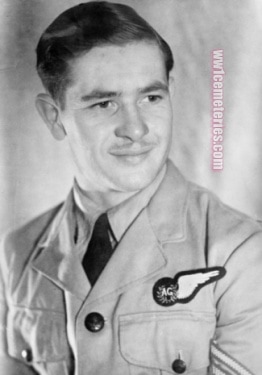
27460 Flight Sergeant
William Kevin Gertzel
Royal Australian Air Force
13th May 1944, aged 20.
Coll. grave IVa. E. 33-34.
Son of Clarice Gertzel, of Perth, Western Australia.
Enlisting in the RAAF in July 1942, Flt Sgt Gertzel trained in Australia and Canada as a Wireless Air Gunner (WAG) under the Empire Air Training Scheme (EATS) and was posted to 466 Squadron RAAF at RAF Leconfield, Yorkshire, England. Flt Sgt Gertzel was listed as missing when his Halifax bomber, serial number LV919, radio call-sign HD-O (O-Oboe) failed to return from an operational sortie over the bomb marshalling yards at Hasselt, Germany on the night of 12/13th May 1944. It was determined after the war that LV919 was shot down by a German night-fighter and crashed at Zondereigen, Belgium. All seven crew members were killed.
William Kevin Gertzel
Royal Australian Air Force
13th May 1944, aged 20.
Coll. grave IVa. E. 33-34.
Son of Clarice Gertzel, of Perth, Western Australia.
Enlisting in the RAAF in July 1942, Flt Sgt Gertzel trained in Australia and Canada as a Wireless Air Gunner (WAG) under the Empire Air Training Scheme (EATS) and was posted to 466 Squadron RAAF at RAF Leconfield, Yorkshire, England. Flt Sgt Gertzel was listed as missing when his Halifax bomber, serial number LV919, radio call-sign HD-O (O-Oboe) failed to return from an operational sortie over the bomb marshalling yards at Hasselt, Germany on the night of 12/13th May 1944. It was determined after the war that LV919 was shot down by a German night-fighter and crashed at Zondereigen, Belgium. All seven crew members were killed.

420099 Trooper
William John Tyrie
2nd Fife and Forfar Yeomanry, Royal Armoured Corps
16th December 1944.
Plot V. D. 16.
Son of James Bruce and Laura Emily Tyrie; husband of Dorothy Tyrie, of Perth.
William John Tyrie
2nd Fife and Forfar Yeomanry, Royal Armoured Corps
16th December 1944.
Plot V. D. 16.
Son of James Bruce and Laura Emily Tyrie; husband of Dorothy Tyrie, of Perth.
Belgian War Graves
Other Nationalities
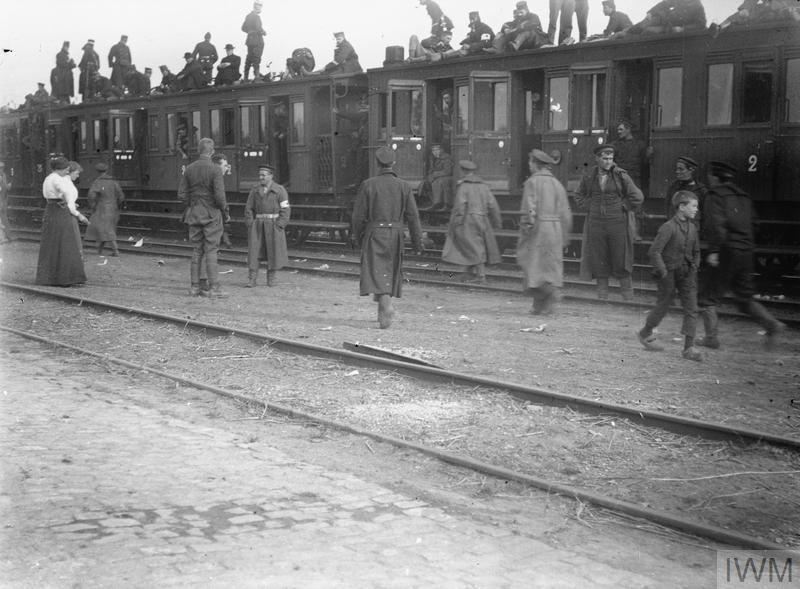
Packed inside and out. This was the last train from Antwerp; the next one was attacked by Germans and most of the troops were captured. The 2nd R. N. Brigade, the Chatham and Deal Battalions and the Drake Battalion entrained at St. Gillaes Waes. The Portsmouth Battalion and 600 stragglers from the Naval Battalions entrained at Kernaeke and were derailed and attacked on the 9th October 1914. © IWM Q 14782


